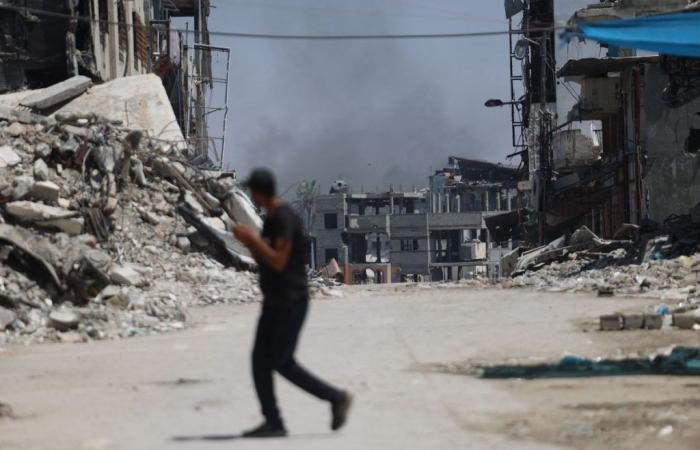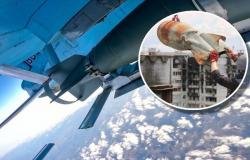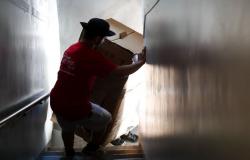– Fighting pits Israeli army against Hamas fighters
The northern Gaza Strip has been the scene of violent clashes. Living conditions for residents are “dire” according to the UN agency for Palestinian refugees (UNRWA).
Published today at 2:48 p.m.
A Palestinian man crosses a street as smoke rises from an area targeted by Israeli shelling in the background, in Shajaya district of Gaza City, June 28, 2024.
Omar AL-QATTAA / AFP)
Subscribe now and enjoy the audio playback feature.
BotTalk
The war, triggered by an unprecedented attack by the Islamist movement in Israel on October 7, is continuing unabated across the Palestinian territory, and raises fears of a flare-up in Lebanon.
Fierce fighting pitted the Israeli army against Hamas fighters on Saturday in the north of the Gaza Strip, where the living conditions of residents are “disastrous” according to the UN agency for Palestinian refugees (UNRWA).
The war, triggered by an unprecedented attack by the Islamist movement in Israel on October 7, is continuing unabated across the Palestinian territory, and raises fears of a flare-up in Lebanon.
Israeli troops launched a ground offensive on May 7 in the town of Rafah (south), then presented by Israel as the last major bastion of Hamas. But the fighting has since regained intensity in several other regions, particularly in the north.
“Tens of thousands of civilians” flee
Since Thursday, the Israeli army has been carrying out an operation in Shujaiya, an eastern district of Gaza City, where it says there are “terrorist infrastructures.”
Civil Defense reported on Friday “numerous deaths” and the flight of “tens of thousands of civilians”, after a call from the army to evacuate the neighborhood.
“In the streets, people were panicking, they were terrified (…) Everyone was leaving Shujaiya,” says Samah Hajaj, 42. “We don’t know why they (Israeli soldiers, editor’s note) entered Shujaiya since they had already destroyed the houses there.”
Explosions and airstrikes
During the night and Saturday morning, AFP journalists heard explosions, airstrikes and gunfire coming from this area.
The Israeli army said on Friday it had eliminated “a large number of terrorists and located a weapons depot in a school.”
Also in Gaza City, the Civil Defense said four bodies and six wounded were recovered from the rubble of a building hit by an Israeli strike in the al-Sedra area.
In the centre of the Palestinian territory, where the army said it had eliminated “numerous” fighters, residents were clearing rubble in the Maghazi refugee camp after an overnight strike on a house that hit a medical centre.
“The pharmacy, ophthalmology department and emergency department were completely destroyed. All that remains is debris,” said Tarek Qandeel, director of the center.
Five bodies discovered
Further south, five bodies were discovered following a bombing on displaced people’s tents in the al-Mawasi sector, near Rafah, according to doctors.
The army is continuing operations in the latter city, which borders Egypt, saying it has eliminated “numerous terrorists” there.
Witnesses reported deaths and injuries among the displaced in the Shakush camp, west of Rafah, after a new incursion by the Israeli army and shooting. A source at the Nasser Medical Center in Khan Younis said they received four bodies from west of Rafah.
The Hamas attack on October 7 in Israel resulted in the deaths of 1,195 people, mostly civilians, according to an AFP count based on official Israeli data.
During the attack, 251 people were abducted, 116 of whom are still being held in Gaza, among whom 42 died, according to the army.
Israel has promised to destroy Hamas, in power in Gaza since 2007 and which it considers a terrorist organization, as do the United States and the European Union.
Its offensive on the Gaza Strip has so far left 37,834 dead, mostly civilians, according to data from the Health Ministry of the Hamas-led Gaza government.
Humanitarian disaster
The war has caused a humanitarian catastrophe in the small, besieged Palestinian territory of 2.4 million inhabitants, more than half of whom have been displaced: water and food are lacking and the health system is on its knees.
A total of 32 hospitals out of 36 in the Gaza Strip have been damaged since October 7, and among them 20 are now out of service, according to figures released Friday by the World Health Organization (WHO).
An UNRWA mission manager, Louise Wateridge, described Friday as “disastrous” the living conditions in the Palestinian territory, where humanitarian aid is arriving in trickles.
Residents are living in ruins of buildings or tents around a gigantic pile of rubbish, she told reporters in Geneva, via video link from the centre of the Gaza Strip.
“There is no water, no sanitation, no food,” she added about Khan Younes (south).
Towards a conflict in Lebanon?
Fears that the conflict could spread to Lebanon have recently been heightened by a verbal escalation between Israel and Hamas’ ally Hezbollah.
Since October 7, the two sides have been exchanging fire almost daily in the border area, with deadly violence causing thousands of residents to flee on both sides of the border.
Hezbollah said Friday it had launched several attacks on Israeli military positions near the border, and announced the death of one of its fighters, killed by Israeli fire.
Tehran, its ally, warned Israel on Saturday that the “axis of resistance”, which includes Iran and its regional allies, could mobilize if it launched a “large-scale” offensive in Lebanon.
On Wednesday, Israeli Defense Minister Yoav Gallant said Israel did not want war with Hezbollah, but warned that his country had “the capacity to return Lebanon to the Stone Age.”
“Latest news”
Want to stay on top of the news? “24 Heures” offers you two appointments per day, directly in your email box. So you don’t miss anything that’s happening in your Canton, in Switzerland or around the world.
Other newsletters
To log in
AFP
Did you find an error? Please report it to us.
0 comments






